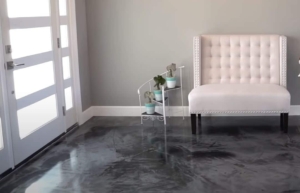
Eco-Friendly Options in Epoxy Flooring: Sustainable Solutions for Modern Spaces
Introduction
In today’s environmentally conscious world, sustainability has become a top priority in various industries, including construction and design. As the demand for eco-friendly building materials continues to rise, epoxy flooring emerges as a sustainable solution for modern spaces. This comprehensive guide will explore the importance of sustainability in construction and design, delve into eco-friendly options available in epoxy flooring, and discuss their positive impact on environmental sustainability.
The Importance of Sustainability in Construction and Design
Sustainability has become a critical consideration in construction and design due to growing concerns about climate change, resource depletion, and environmental degradation. Architects, designers, and building owners are increasingly seeking ways to minimize the environmental impact of their projects by incorporating sustainable materials and practices. By choosing eco-friendly building materials, such as epoxy flooring, construction professionals can reduce carbon emissions, conserve natural resources, and create healthier, more resilient built environments.
Recycled Materials in Epoxy Flooring
One of the key eco-friendly options in epoxy flooring is the use of recycled materials. Epoxy flooring products made from recycled materials offer a sustainable alternative to traditional flooring materials, such as concrete or vinyl. These products are manufactured using reclaimed materials, such as recycled glass, rubber, or plastic, diverting waste from landfills and reducing the demand for virgin materials. By choosing epoxy flooring made from recycled materials, builders and designers can minimize their environmental footprint and support the circular economy.
Low VOC Formulations for Indoor Air Quality
Volatile organic compounds (VOCs) are chemicals emitted as gases from certain materials, including some flooring products, paints, and adhesives. High levels of VOC emissions can contribute to indoor air pollution and pose health risks to occupants. To address this issue, many manufacturers offer epoxy flooring with low VOC formulations. These formulations are engineered to minimize emissions of harmful chemicals, creating healthier indoor environments for building occupants. By choosing epoxy flooring with low VOC emissions, builders and designers can improve indoor air quality and promote the well-being of building occupants.
Energy-Efficient Properties of Epoxy Flooring
In addition to using recycled materials and low VOC formulations, epoxy flooring can contribute to energy efficiency in modern spaces. Epoxy flooring is known for its high reflectivity, which can help enhance natural light distribution within a space. By reflecting natural light more efficiently, epoxy flooring can reduce the need for artificial lighting, resulting in energy savings and lower electricity consumption. Furthermore, epoxy flooring can be installed with light-colored finishes, which further enhances its light-reflective properties and contributes to a brighter, more energy-efficient environment.
Durability and Longevity of Epoxy Flooring
Another aspect of sustainability in epoxy flooring is its durability and longevity. Epoxy flooring is highly resistant to wear, stains, and impacts, making it a long-lasting flooring solution for commercial, industrial, and residential spaces. Unlike traditional flooring materials, such as carpet or vinyl, epoxy flooring does not need to be replaced frequently, reducing the amount of waste generated and the need for new materials. By choosing epoxy flooring for their projects, builders and designers can create sustainable spaces that withstand the test of time.
Maintenance Benefits of Epoxy Flooring
Epoxy flooring offers several maintenance benefits that contribute to its sustainability. The seamless surface of epoxy flooring eliminates grout lines and seams where dirt, dust, and bacteria can accumulate, resulting in a hygienic and easy-to-clean flooring solution. Unlike traditional flooring options that may require frequent scrubbing, waxing, or polishing to maintain their appearance, epoxy flooring can be effortlessly cleaned with a simple mop and mild detergent, saving time, water, and energy. Additionally, epoxy flooring is highly resistant to chemicals and spills, reducing the need for harsh cleaning agents and minimizing environmental impact.
LEED Certification and Epoxy Flooring
Leadership in Energy and Environmental Design (LEED) certification is a widely recognized green building certification program that promotes sustainability in building design, construction, and operation. Epoxy flooring can contribute to LEED certification in several ways, including its use of recycled materials, low VOC formulations, and energy-efficient properties. By incorporating epoxy flooring into their projects, builders and designers can earn LEED credits and demonstrate their commitment to environmental sustainability.
Case Studies: Examples of Sustainable Epoxy Flooring Projects
To illustrate the practical application of eco-friendly options in epoxy flooring, it’s beneficial to examine real-world examples of sustainable projects. Case studies highlighting successful installations of recycled materials, low VOC formulations, and energy-efficient epoxy flooring in various commercial, industrial, and residential spaces can provide valuable insights and inspiration for builders and designers seeking to incorporate sustainability into their projects.
Conclusion
In conclusion, epoxy flooring offers sustainable solutions for modern spaces by incorporating eco-friendly options such as recycled materials, low VOC formulations, and energy-efficient properties. By choosing epoxy flooring for their projects, builders and designers can minimize their environmental footprint, improve indoor air quality, and create durable, long-lasting spaces that contribute to the well-being of building occupants and the health of the planet. As sustainability continues to be a top priority in construction and design, epoxy flooring stands out as a versatile and environmentally responsible choice for a wide range of applications.
